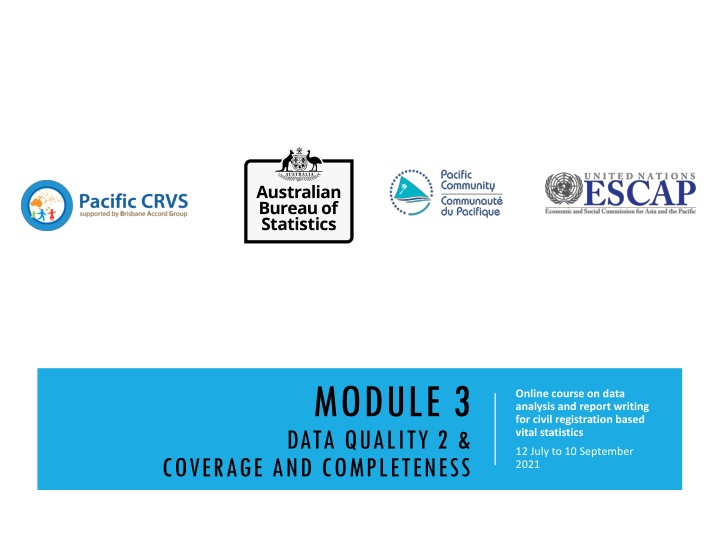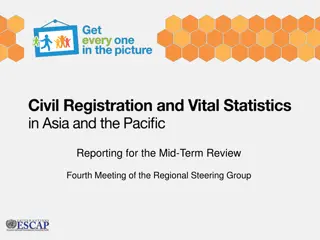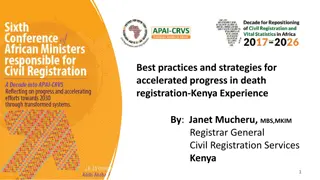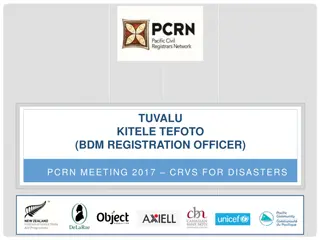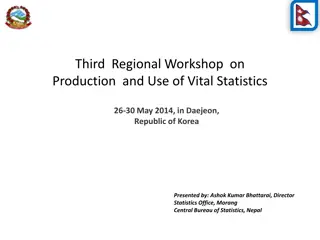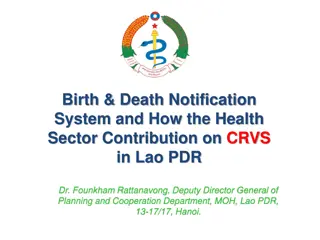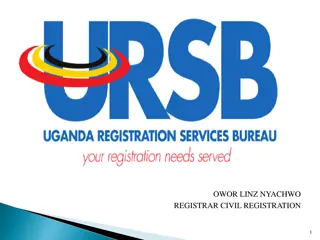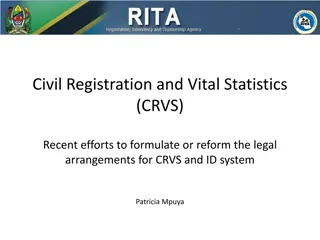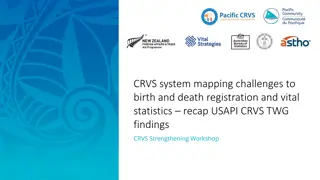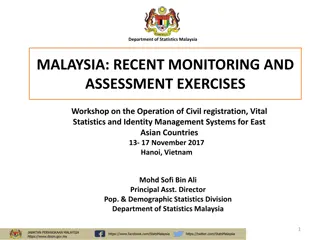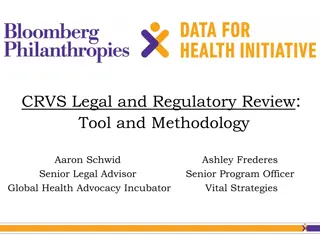Online Course on Data Analysis for Civil Registration Vital Statistics
Discover an online course focusing on data analysis and report writing for civil registration-based vital statistics. This course, running from July 12 to September 10, 2021, covers aspects of data quality, completeness, and producing essential tables for analysis. Gain insights into generating total births by year, by sex, age of mother, geographic sub-regions, and major ethnicities. Explore guidelines for creating informative tables with clear titles, references, and data presentation techniques. Enhance your skills in presenting data effectively through this comprehensive course.
Download Presentation

Please find below an Image/Link to download the presentation.
The content on the website is provided AS IS for your information and personal use only. It may not be sold, licensed, or shared on other websites without obtaining consent from the author.If you encounter any issues during the download, it is possible that the publisher has removed the file from their server.
You are allowed to download the files provided on this website for personal or commercial use, subject to the condition that they are used lawfully. All files are the property of their respective owners.
The content on the website is provided AS IS for your information and personal use only. It may not be sold, licensed, or shared on other websites without obtaining consent from the author.
E N D
Presentation Transcript
MODULE 3 DATA QUALITY 2 & Online course on data analysis and report writing for civil registration based vital statistics 12 July to 10 September 2021 COVERAGE AND COMPLETENESS
VITAL STATISTICS REPORT TEMPLATE CONTENT
BASIC TABLES NEEDED FOR ANALYSIS For births: - Total Number of births by year Did you manage to produce these tables? Did you face any specific challenge? Any insight from the process? } - Total Births by year by sex - Number of births by year, by age of mother (5-year age groups) - Number of births by geographic sub-region (where relevant) (and potentially by sex and age of mother if there is sufficient data) - Number of births by major ethnicity (where relevant)
GUIDELINES FOR TABLES FOR REPORTS Have a clear title Have a reference to the table (such as a table number) Provide the total to give summary information (especially the total number if showing percentages) Space the table entries so that the table is easy to read Source: Samoa 2009 DHS https://dhsprogram.com/pubs/pdf/FR240/FR240.pdf
GUIDELINES FOR TABLES FOR REPORTS Include the source of the data Have rows and columns clearly labelled Use vertical and horizontal lines to separate the labels from the data themselves Usually do not have the columns separated by vertical lines or rows by horizontal lines this splits the table up too much Source: Samoa 2009 DHS https://dhsprogram.com/pubs/pdf/FR240/FR240.pdf
GUIDELINES FOR TABLES FOR REPORTS Specify the units of the data in the table Put numbers most likely to be compared with each other in adjacent columns Where practical, put columns with larger values at the left of the table, and columns with smaller values at the right of the table Do not use more than two decimal places with percentages Source: Samoa 2009 DHS https://dhsprogram.com/pubs/pdf/FR240/FR240.pdf
PERCENTAGES To change an amount to a percentage divide it by the total and multiply by 100. Do not show more than one decimal with percentages: you should round the raw figures. The total of the percentages should add up to 100 (rounding excepted) When showing all categories that add up to 100 percent, label your figure as a Percent Distribution You should report somewhere in your table what number was used for the total i.e. how many cases = 100%
AGGREGATING DATA OVER TIME When computing indicators that are not simply numbers of events (e.g. completeness, fertility or mortality rates), single year data is likely to be unstable and is not recommended due to small population sizes and disaggregation for sex, age groups or other variables. Minimum aggregations of 3 years, although 5 years may be more suitable in smaller countries. Annual reports are likely to be less useful than investing in reporting at a more detailed level every 3 or so years. Depending on your data, determine whether 3- or 5-year aggregation is appropriate. It is preferable that the same time periods are used for births and for deaths for consistency.
DATA QUALITY OF TABULATED DATA After having checked individual records thoroughly (cf Module 2), we should still keep data quality in mind when tabulating it. Shortfalls can be observed in: Consistency Coverage (or scope) Representativeness Completeness Validity Reliability Bias
DATA QUALITY OF TABULATED DATA CONSISTENCY Consistency - a description of the data over time, and whether it follows a similar pattern from year to year, month to month, etc. Are there significant gaps or peaks in our data set? Best assessed from tabulations or graphs of the total number of events by year or month. Good practice to examine sub-regions, as well, to identify any reporting problems in the data. The very small populations of PICTs and subsequently the small numbers of births and deaths can result in poor consistency of data over time due purely to random effects. Data should be aggregated over 3-5 years before calculating measures of fertility or mortality to account for this. It poses the question of Reliability Is your CRVS system able to produce results of a similar quality over time?
DATA QUALITY OF TABULATED DATA COVERAGE & REPRESENTATIVENESS Coverage - describes the area or population that the data set includes, noting any groups of events that may be missing. For example, coverage of a CRVS system may be national, or it may in practice exclude remote and rural areas, outer islands, births or deaths overseas, or events related to foreign nationals or non- residents. Representativeness is how well the data you collected reflects the broader population for which you want to use the results. Related to coverage, was the entire population included? Those issues can create Bias,a systematic effect on a statistic or measurement rather than a stochastic or random one.
DATA QUALITY OF TABULATED DATA VALIDITY Validity - the plausibility of the raw data (in terms of number of events) and of calculated measurements. For example, it is generally implausible that the infant mortality rate would be substantially different for males and females. One way of assessing validity is through comparison with other data sources: if similar data from other sources exist, they should be identified. Do you have comparable data from the civil registry and the health system? Do your results match those from the census? From household surveys? How different are they? Where appropriate, a reconciliation should be attempted describing how the data sets differ and the reasons for these differences
OFF-ISLAND EVENTS Births and deaths occurring off-island can impact the measurement of some indicators fertility, mortality, causes of death, etc. Depending on the standard for data collection in the country collecting events of residents occurring abroad, or events of foreigners occurring locally the same should be applied constantly and properly recorded, to be able to differentiate during analysis.
DATA QUALITY OF TABULATED DATA COMPLETENESS Completeness assesses what proportion of the events that we intended to capture did we manage to collect data for. In the context of CRVS, it can mean two things: Content completeness: How complete and reliable (by variable) is the unit record data you have to work with for the population covered? For example, what is the proportion of birth records that do not include the sex of the child? Registration completeness: What is the proportion of events occurring in the population that are recorded? For example, if our area of coverage is births in the national hospital, what proportion of the births in the hospital were recorded in our data set? Generally, 90% completeness for CRVS can be used for analysis without adjustment (although the completeness should be reported for context).
REGISTRATION COMPLETENESS Computing the registration completeness allows to monitor the performance of the registration system: How large is the gap to universal registration? Is this gap diminishing over time? If possible, it can also be disaggregated by several variables to get a better sense of what needs improvement in the system: Is coverage of birth registration lower for girls? Do some islands have lower registration levels? It is a critical indicator when trying to improve the CRVS system. To compute completeness, one needs either another separate source of individual data, or an estimate of the total number of events, national or international.
OBSERVED VS EXPECTED EVENTS The number of registered births (numerator) would be sourced from the civil registration authority. National estimates on the number of births (denominator) can be developed based on estimates from the ministry of health, population census data or sample surveys. In the absence of national estimates, birth rates produced by the United Nations Population Division or by the Pacific Community can be used for the denominator, as follows: Number of registered births *100 Crude birth rates as estimated by your NSO, the UN or SPC (per 1000) x Total pop size (in 000s) Useful resources: UN Population Division, Annual Demographic Indicators https://population.un.org/wpp/Download/Standard/Interpolated/ SPC, Demographic projections https://pacificdata.org/data/organization/spc-sdd
REGISTRATION DELAYS Though not as critical as registration completeness, another key indicator of the performance of the CRVS system is the proportion of events that are registered in-time. The legally stipulated time is the time allotted by law to the registration of events. For example, in Kiribati birth registration should take place within 10 days, and death registration within 5. There usually is a tolerance period during which registrations are considered late After this period (usually 1 year), registrations are considered delayed Analyzing delays can provide insights on issues faced by the registration system The fewer late and delayed registrations, the better!
Important tip: Make sure to keep a note of every change you make to your dataset as you go along!! ASSIGNMENT In Excel: 1. Have a look at the tabulations produced last week: - Are births consistent over time? - Do disaggregated tables show different trends for categories (for ex. by sex)? - If anything is different than expected, try to understand why and discuss it with your facilitators 2. How complete are your birth records for key variables? Proportion of individual records missing date of event, sex, age of mother and place. 3. Can you find an estimate of the number of births by year which occurred in your country, and estimate birth registration completeness by year from it? Once you have calculated it, you can fill Table 3.4 of the Report template (p.23) and describe your findings in a short text. Report template: https://getinthepicture.org/resource/production-vital-statistics-guide-rev-1
